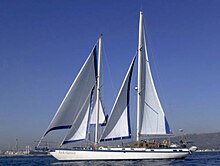This article needs additional citations for verification. (June 2019) |




Ferrocement or ferro-cement[1] is a system of construction using reinforced mortar[2] or plaster (lime or cement, sand, and water) applied over an "armature" of metal mesh, woven, expanded metal, or metal-fibers, and closely spaced thin steel rods such as rebar. The metal commonly used is iron or some type of steel, and the mesh is made with wire with a diameter between 0.5 mm and 1 mm. The cement is typically a very rich mix of sand and cement in a 3:1 ratio; when used for making boards, no gravel is used, so that the material is not concrete.
Ferrocement is used to construct relatively thin, hard, strong surfaces and structures in many shapes such as hulls for boats, shell roofs, and water tanks. Ferrocement originated in the 1840s in France and the Netherlands and is the precursor to reinforced concrete. It has a wide range of other uses, including sculpture and prefabricated building components. The term "ferrocement" has been applied by extension to other composite materials, including some containing no cement and no ferrous material.[citation needed]
The "Mulberry harbours" used in the D-Day landings were made of ferrocement, and their remains may still be seen at resorts like Arromanches.